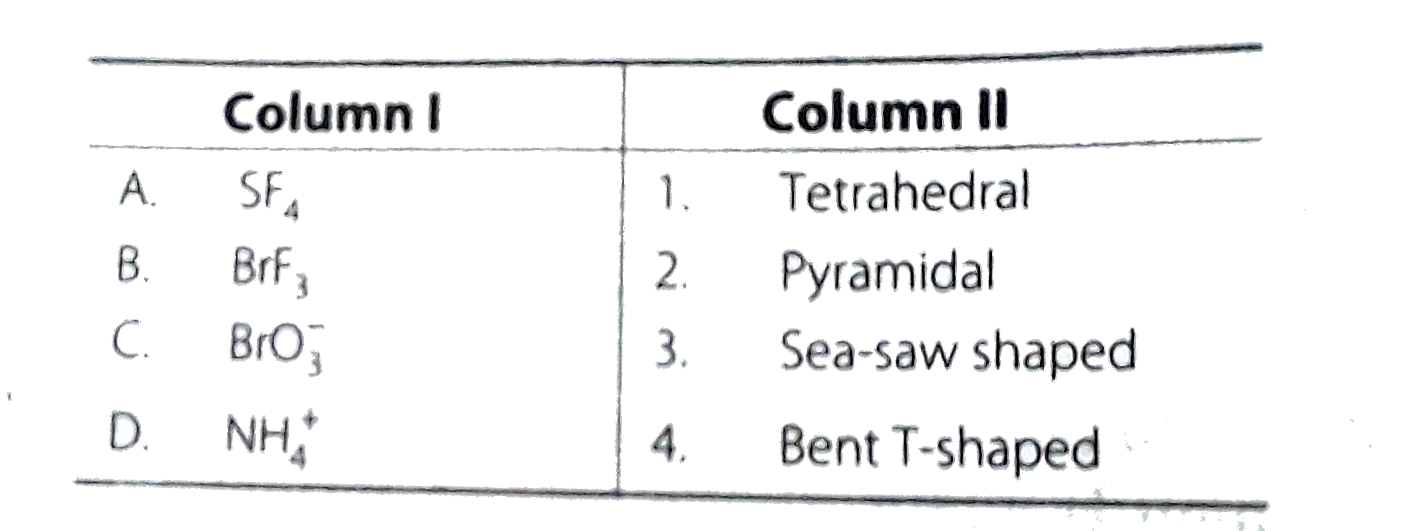Match the species given in Column I with the properties mentioned in Column II
To solve the matching question, we will analyze each species in Column I and determine their corresponding properties in Column II step by step.
Step 1: Analyze BF₄⁻
- Species: BF₄⁻
- Valence Electrons: Boron (B) has 3 valence electrons, and there are 4 fluorine (F) atoms, each contributing 1 electron. Since it is an anion (negative charge), we add 1 electron.
- Calculation:
- Total valence electrons = 3 (B) + 4 (F) + 1 (charge) = 8
- Hybridization = (8 / 2) = 4 (indicating sp³ hybridization).
- Shape: Tetrahedral.
- Match: A matches with 5 (Tetrahedral shape).
Step 2: Analyze AlCl₃
- Species: AlCl₃
- Valence Electrons: Aluminum (Al) has 3 valence electrons and is bonded to 3 chlorine (Cl) atoms.
- Electron Deficiency: Al has only 6 electrons in its valence shell after bonding, which means it has an incomplete octet and can accept electrons.
- Lewis Acid: This property makes AlCl₃ a Lewis acid.
- Match: B matches with 3 (Lewis acid).
Step 3: Analyze SnO
- Species: SnO
- Oxidation States: Tin (Sn) can have oxidation states of +2 and +4. In SnO, Sn is in the +2 oxidation state.
- Further Oxidation: Since Sn can exist in a +4 state, SnO can be further oxidized to SnO₂.
- Match: C matches with 4 (Can be further oxidised).
Step 4: Analyze PbO₂
- Species: PbO₂
- Oxidation State: Lead (Pb) in PbO₂ has an oxidation state of +4.
- Strong Oxidizing Agent: PbO₂ can act as a strong oxidizing agent because it can be reduced to Pb²⁺, which is more stable due to the inert pair effect.
- Match: D matches with 1 (Oxidation state of central atom is +4) and also with 2 (Strong oxidising agent).
Final Matches:
- A → 5 (Tetrahedral shape)
- B → 3 (Lewis acid)
- C → 4 (Can be further oxidised)
- D → 1 (Oxidation state of central atom is +4) and 2 (Strong oxidising agent)
Summary of Matches:
- A → 5
- B → 3
- C → 4
- D → 1 and 2
- Species: BF₄⁻
- Valence Electrons: Boron (B) has 3 valence electrons, and there are 4 fluorine (F) atoms, each contributing 1 electron. Since it is an anion (negative charge), we add 1 electron.
- Calculation:
- Total valence electrons = 3 (B) + 4 (F) + 1 (charge) = 8
- Hybridization = (8 / 2) = 4 (indicating sp³ hybridization).
- Shape: Tetrahedral.
- Match: A matches with 5 (Tetrahedral shape).
- Species: AlCl₃
- Valence Electrons: Aluminum (Al) has 3 valence electrons and is bonded to 3 chlorine (Cl) atoms.
- Electron Deficiency: Al has only 6 electrons in its valence shell after bonding, which means it has an incomplete octet and can accept electrons.
- Lewis Acid: This property makes AlCl₃ a Lewis acid.
- Match: B matches with 3 (Lewis acid).
- Species: SnO
- Oxidation States: Tin (Sn) can have oxidation states of +2 and +4. In SnO, Sn is in the +2 oxidation state.
- Further Oxidation: Since Sn can exist in a +4 state, SnO can be further oxidized to SnO₂.
- Match: C matches with 4 (Can be further oxidised).
- Species: PbO₂
- Oxidation State: Lead (Pb) in PbO₂ has an oxidation state of +4.
- Strong Oxidizing Agent: PbO₂ can act as a strong oxidizing agent because it can be reduced to Pb²⁺, which is more stable due to the inert pair effect.
- Match: D matches with 1 (Oxidation state of central atom is +4) and also with 2 (Strong oxidising agent).
- A → 5 (Tetrahedral shape)
- B → 3 (Lewis acid)
- C → 4 (Can be further oxidised)
- D → 1 (Oxidation state of central atom is +4) and 2 (Strong oxidising agent)
- A → 5
- B → 3
- C → 4
- D → 1 and 2
Topper's Solved these Questions
- THE P-BLOCK ELEMENTSBook:NCERT EXEMPLAR ENGLISHChapter:THE P-BLOCK ELEMENTSExercise:Assertion and Reason
Explore 2 Videos
- THE P-BLOCK ELEMENTSBook:NCERT EXEMPLAR ENGLISHChapter:THE P-BLOCK ELEMENTSExercise:Long Answer
Explore 9 Videos
- THE P-BLOCK ELEMENTSBook:NCERT EXEMPLAR ENGLISHChapter:THE P-BLOCK ELEMENTSExercise:Short Answer
Explore 14 Videos
- STRUCTURE OF ATOMBook:NCERT EXEMPLAR ENGLISHChapter:STRUCTURE OF ATOMExercise:All Questions
Explore 55 Videos
- THE S-BLOCK ELEMENTS Book:NCERT EXEMPLAR ENGLISHChapter:THE S-BLOCK ELEMENTS Exercise:Long Answer Type Questions
Explore 8 Videos
Similar Questions
Match the statements given in Column I with the oxidation states given in Column II.

View SolutionMatch the species given in Column I with the shape given in Column II and mark the correct option.

View SolutionMatch the species given in Column I with properties given in Column II
Column-IColumn-IIA.Diborane1.Used as a flux for soldering metalsB.Gallium2.Crystalline form of silicaC.Borax3.Banana bondsD.Aluminossilicate4.Low melting, high boiling, useful for measuring high temperaturesE.Quartz5.Used as catalyst in petrochemical industries
View SolutionMatch the types of colloidal systems given in Column I with the name given in Column II.
Column IColumn IIA.Solid in liquid1.FoamB.Liquid in solid 2.SolC.Liquid in liquid 3.GelD.Gas in liquid4.Emulsion
View SolutionMatch the elements given in Column I with the properties mentioned in Column II.
ColumnIColumnIIA.Li1.Insoluble sulphateB.Na2.Strongest monoacidic baseC.Ca3.Most negativeEΘvalue among alkali metalsD.Ba4.Insoluble oxalate5.6s2outer electronic configuration
View SolutionMatch the species given in Column I with hybridisation given in Column II.
Column-IColumn-IIA.Boron in[B(OH4)]−1.sp2B.Aluminium in[Al(H2O)6]3+2.sp3C.Boron in B2H63.sp3d2D.Carbon in buckminster fullereneE.Silicon in SiO4−4F.Germanium in[GeCl6]2−
View SolutionMatch the elements given in column (I) with the most appropriate expected values given in column (II)
Column IColumn IIElementElectronegative valuesA.F(p)3.5B.O(q)3.0C.N(r)4.0D.C(s)2.5
View SolutionMatch the terms in column I with those in column II .
Column IColumn IIA.TrypsinPancreasB.AmylaseLiverC.BileGastric glandsD.PepsinSaliva
View SolutionMatch Column I with Column II for the given properties/ applications mentioned therein.

View SolutionMatch the shape of molecules in Column 1 with the type of hybridisation in Column II.
Column IColumn II(a)Tetrahedral(i)sp2(b)Trigonal(ii)sp(c)Linear(iii)sp3(d)Trigonal bipyramidal(iv)sp3d
View Solution